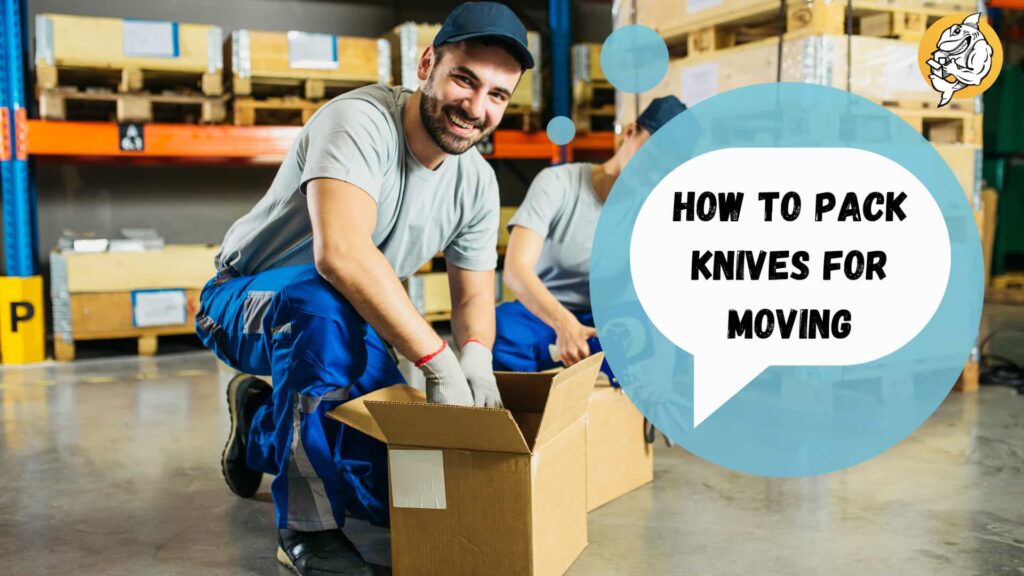How To Pack Knives For Moving

Summary: This all-inclusive guide by QShark Moving Company lays out detailed instructions on How To Pack Knives For Moving. From preparation to final packing, we cover all the crucial steps in an easy-to-follow manner to ensure a smooth and hazard-free moving experience. This guide is ideal for everyone – from local movers to long-distance adventurers.
| Section | Key Points |
|---|---|
| Importance of Properly Packing Knives for Moving | Prevents injuries, protects other items, preserves knives |
| Preparation Before Packing | Clean and dry knives, gather packing materials |
| Packing Individual Knives | Wrap blade with packing paper, secure with tape, wrap knife with bubble wrap, label |
| Packing Knife Sets | Secure knives in block, wrap block, place in box, fill extra space |
| Choosing the Right Box | Select a strong, appropriately sized box with room for padding |
| Securing and Labeling the Box | Tape the box securely, label with “Fragile” and “Sharp Objects Inside” |
| Safety Measures During the Move | Careful loading, handle with caution when unpacking |
I. Introduction
Packing can be one of the most daunting tasks when preparing for a move. And when it comes to packing sharp objects like knives, it becomes a matter of safety too. As professional movers, we understand the need for meticulous planning and attention to detail, especially for packing potentially hazardous items.
At QShark Moving Company, we ensure clients have a seamless and safe moving experience. This is why we’ve compiled this comprehensive guide to help you understand how to pack knives safely and efficiently. This guide is a part of our larger series about moving, aimed at making your move as smooth as possible. Whether you’re local movers shifting to a new neighborhood or moving across states, this guide will be indispensable.
In this guide, you’ll learn:
- The importance of correctly packing knives for moving
- How to prepare your knives for packing
- A step-by-step guide to packing individual knives and knife sets
- Tips on selecting the right box for packing
- How to securely and appropriately label the boxes
- Safety measures during the move and while unpacking
With these pointers at your fingertips, you can become your expert packer, ensuring your cutlery arrives at your new home safe and sound.

II. Importance of Properly Packing Knives for Moving
Knives are indispensable tools in any kitchen, but their sharp edges can pose significant risks if not properly packed during a move. Mishandling of improperly packed knives could lead to severe injuries. Furthermore, unprotected blades can scratch and damage other items during the move. Thus, the importance of packing knives correctly cannot be overstressed.
Some potential dangers of improperly packed knives include:
- Risk of Injuries: This is the most significant risk. If the sharp edges are not adequately covered, anyone who handles the boxes could be injured.
- Damage to Other Items: Unprotected knives can pierce through the packing material, potentially scratching, cutting, or damaging other items.
- Knife Damage: Improperly packed knives can also get damaged or dulled, reducing lifespan.
III. Preparation Before Packing
Before starting to pack your knives, a little preparation is necessary. This step is often overlooked, but it is crucial in ensuring the long-term quality of your knives and the safety of those involved in the packing and moving process. Here’s what you need to do:
- Clean the Knives: Thoroughly wash each knife to ensure no food particles are left. This step is crucial to prevent rusting and staining of the blades during the move.
- Dry the Knives: After washing, dry each knife thoroughly. Any remaining moisture can lead to rust, which can damage the knife.
- Gather Packing Materials: Prepare all the packing materials you will need. This includes packing paper, bubble wrap, packing tape, and sturdy boxes.
IV. Detailed Step-by-Step Guide to Packing Individual Knives
Packing each knife individually can be time-consuming, but it’s the best way to ensure the safety of your belongings and the movers. Follow these steps to pack each knife:
- Wrap the Blade with Packing Paper: Lay the knife on a piece of packing paper. Please fold the paper over the blade, covering it entirely.
- Secure the Paper with Packing Tape: Secure the blade with a piece of packing tape once fully covered. Be sure not to put tape directly on the blade to avoid leaving any residue.
- Wrap the Knife with Bubble Wrap: For added protection, wrap the knife (blade and handle) with bubble wrap. This adds an extra layer of cushioning.
- Secure the Bubble Wrap with Packing Tape: Tape the bubble wrap to ensure it stays in place during the move.
- Label the Knife for Easy Identification: Write “Knife” or “Sharp” on a masking tape and stick it to the bubble wrap. This will help alert anyone handling the box that sharp objects are inside.

V. Detailed Step-by-Step Guide to Packing Knife Sets
When packing a knife set, especially those with a knife block, you might find these steps useful:
- Secure Individual Knives in the Knife Block: If your knife set comes with a block, ensure each knife is securely placed in its respective slot.
- Wrapping and Securing the Knife Block: Wrap the entire block with the knives in bubble wrap. Secure it with packing tape.
- Packing the Knife Block in a Box: Choose a box that comfortably fits the wrapped block. Add extra padding at the bottom, place the block inside, then fill any remaining space with additional packing material.
- Packing Loose Knife Sets: If your knife set doesn’t come with a block, follow the steps mentioned in Section IV for packing individual knives.
VI. Choosing the Right Box
Choosing a sturdy and appropriately sized box is crucial for packing your knives. A weak box can compromise the safety of the packed knives and risk damaging other items. Similarly, an overly large box can allow the knives to move around during transit, increasing the risk of damage.
Here are some key points to consider when choosing the right box:
- Strength: Choose a box that is strong and in good condition. It should be able to withstand the weight of the knives without collapsing.
- Size: The box should be appropriately sized. It should comfortably accommodate the knives without too much extra space that could allow movement.
- Padding: The box should have enough room to accommodate padding materials for extra protection. You can use old clothes, bubble wrap, or packing peanuts.

VII. Securing and Labeling the Box
Securing and labeling the box properly is important once you have packed the knives and placed them in the box.
- Tape the Box: Use strong packing tape to secure the box. Ensure to tape both the top and bottom for added security.
- Label the Box: Label the box with “Fragile” and “Sharp Objects Inside.” This will ensure anyone handling the box will do so with caution.
VIII. Safety Measures During the Move
After packing, it’s crucial to handle the boxes with care during the moving process. Here are some tips:
- Load the Boxes Correctly: Boxes with knives should be loaded carefully into the moving truck. They should be placed in a stable position and not stacked under heavy items that could crush the box.
- Unpacking Advice: When you reach your new home, be careful while unpacking. Remember the labels and handle the boxes accordingly.
IX. Conclusion How To Pack Knives For Moving
Packing knives for a move requires careful attention to detail to ensure the safety of everyone involved and to prevent damage to your valuable items. By following this comprehensive guide on How To Pack Knives For Moving provided by QShark Moving Company, you can be confident that your knives and other sharp objects will arrive at your new home in the same condition they left the old one. Remember, the key lies in careful wrapping, selecting the right box, and correctly labeling and loading your boxes. Safe moving!


 Do Movers Pack for You? | Qshark Moving Company
Do Movers Pack for You? | Qshark Moving Company Packing Glass Shelves for a Move: A Step-by-Step Guide
Packing Glass Shelves for a Move: A Step-by-Step Guide How to Find the Best Movers for Your Local Move
How to Find the Best Movers for Your Local Move 12 Moving Tips: Do You Need To Be Present For Movers
12 Moving Tips: Do You Need To Be Present For Movers Are Movers Responsible for Damage? Understanding Liability
Are Movers Responsible for Damage? Understanding Liability